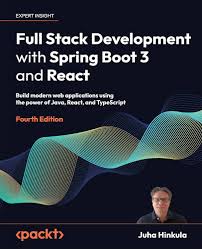White Paper: Full-Stack Java Development with React, Spring Boot, and PostgreSQL
Introduction
In today's rapidly evolving technological landscape, the demand for robust, scalable, and user-friendly web applications is soaring. Full-stack Java development, leveraging the power of React, Spring Boot, and PostgreSQL, offers an exceptional solution to meet these demands. This white paper delves into the compelling advantages of this technology stack, demonstrating its suitability for a wide range of applications.
The Power of Full-Stack Java Development
Full-stack Java development empowers developers to seamlessly construct end-to-end applications, encompassing both frontend and backend components. By utilizing a single language, Java, developers can streamline development processes, enhance code maintainability, and foster efficient collaboration within teams.
Key Technologies: A Synergistic Trio
- React: A versatile JavaScript library for building user interfaces, React excels in creating dynamic and responsive web applications. Its component-based architecture promotes modularity and reusability, facilitating rapid development and efficient updates.
- Spring Boot: A robust framework that simplifies the development of Spring applications. By providing auto-configuration and convention-over-configuration principles, Spring Boot significantly reduces boilerplate code and accelerates development time.
- PostgreSQL: A powerful, open-source relational database management system known for its reliability, scalability, and advanced features. PostgreSQL offers robust data integrity, high performance, and extensive support for complex data structures.
Advantages of the Technology Stack
- Rapid Development:
- Spring Boot's auto-configuration and starter dependencies streamline setup and configuration.
- React's component-based approach enables efficient development and reuse of UI components.
- Scalability:
- Spring Boot seamlessly integrates with cloud-native technologies, facilitating horizontal scaling.
- PostgreSQL's robust architecture and advanced features support high-performance and scalable database operations.
- Robustness and Reliability:
- Java's strong type system and extensive ecosystem contribute to building reliable and secure applications.
- PostgreSQL's ACID compliance and advanced transaction management ensure data integrity.
- Rich Feature Set:
- React's vast ecosystem of libraries and tools empowers developers to build complex and feature-rich user interfaces.
- Spring Boot's integration with various technologies, such as security, caching, and messaging, enables the development of enterprise-grade applications.
- Strong Community and Support:
- Java, React, Spring Boot, and PostgreSQL boast large, active communities, providing extensive documentation, tutorials, and forums.
- Regular updates and security patches ensure the longevity and security of these technologies.
Real-World Applications
The combination of React, Spring Boot, and PostgreSQL is ideal for a multitude of applications, including:
- E-commerce platforms: Build scalable and feature-rich online stores.
- Social media applications: Develop engaging and interactive social networks.
- Enterprise applications: Create robust and secure business solutions.
- Real-time applications: Implement real-time features like chat, notifications, and live updates.
Conclusion
By embracing the power of full-stack Java development with React, Spring Boot, and PostgreSQL, organizations can accelerate development cycles, deliver high-quality applications, and achieve a competitive edge. This technology stack offers a compelling solution for businesses seeking to build innovative and scalable web applications.
Reference List
- Spring Boot Documentation: https://spring.io/projects/spring-boot/
- PostgreSQL Documentation: https://www.postgresql.org/docs/current/
- Oracle Java Documentation: [invalid URL removed]
[Add more references as needed]
Note: To make this white paper even more persuasive, consider adding specific examples of successful projects built with this technology stack, along with testimonials from developers and businesses. Visual aids like diagrams and charts can also enhance the overall impact of the document.



